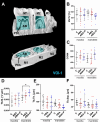Preventive effect of probiotics on periodontal ligament in a rat model of anorexia nervosa
- PMID: 40456862
- PMCID: PMC12130194
- DOI: 10.1038/s41598-025-02610-x
Preventive effect of probiotics on periodontal ligament in a rat model of anorexia nervosa
Abstract
The rising prevalence of anorexia nervosa (AN), especially among adolescents, and the limited understanding of its effects on the periodontium often hinder decision making in dentistry and periodontology. As an adjunct to periodontal therapy, probiotic administration has shown promising effects on oral health by decreasing pathogen counts and altering the immune response. This study thus investigates changes in morphology and remodelling of alveolar bone and periodontal ligament (PDL) due to an AN-like condition, along with potential protective effects of probiotics, using a rat model. Three-week-old female Wistar rats were divided into three groups: a control group with ad libitum food and two groups undergoing an activity-based anorexia (ABA) model. One ABA group received oral multi-strain probiotics during starvation. After five weeks, all rats were sacrificed for ex-vivo micro-CT scans of the maxilla and mandible to assess alveolar bone and PDL morphology, as well as histological evaluations for PDL fibre vitality and structural organization. The data were statistically evaluated by one-way ANOVA with Tukey's post-hoc test or by Kruskal-Wallis with Dunn's test for parametric or nonparametric data, respectively. The results showed no structural changes in alveolar bone caused by either ABA or probiotic treatment; however, the ABA group exhibited a significant reduction in PDL thickness, which could not be reversed by probiotic treatment. Despite this, histological analysis indicated improved connectivity and density of PDL fibres in the probiotic group compared with the ABA-only group. No differences were found between the mandible and maxilla. In conclusion, while probiotics did not prevent PDL thinning, they enhanced its composition/vitality compared to the ABA condition alone.
Keywords: Activity-based anorexia model; Anorexia nervosa; Dentistry; Periodontal and alveolar bone remodeling; Periodontal ligament; Periodontology; Probiotics; Tomography.
© 2025. The Author(s).
Conflict of interest statement
Declarations. Competing interests: The authors declare no competing interests.
Figures





References
-
- Kohn, M. & Golden, N. H. Eating disorders in children and adolescents: Epidemiology, diagnosis and treatment. Paediatr. Drugs3, 91–99 (2001). - PubMed
-
- Keski-Rahkonen, A. et al. Epidemiology and course of anorexia nervosa in the community. Am. J. Psychiatry164, 1259–1265 (2007). - PubMed
-
- Science (IJDOS), I. J. of D. and O. Proportion of Orthodontic Patients Seeking Adult Orthodontic Treatment. SciDoc Publishers (2021).
MeSH terms
LinkOut - more resources
Full Text Sources
Research Materials

